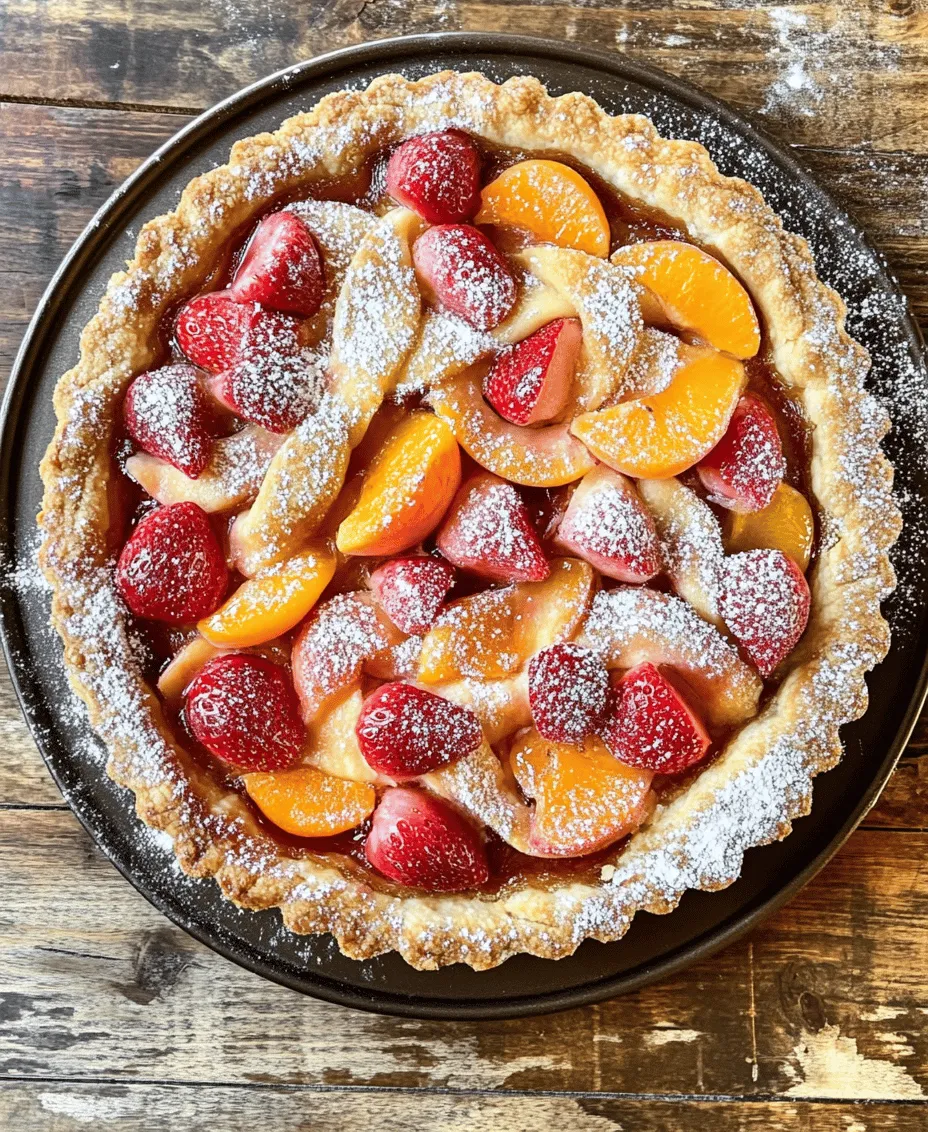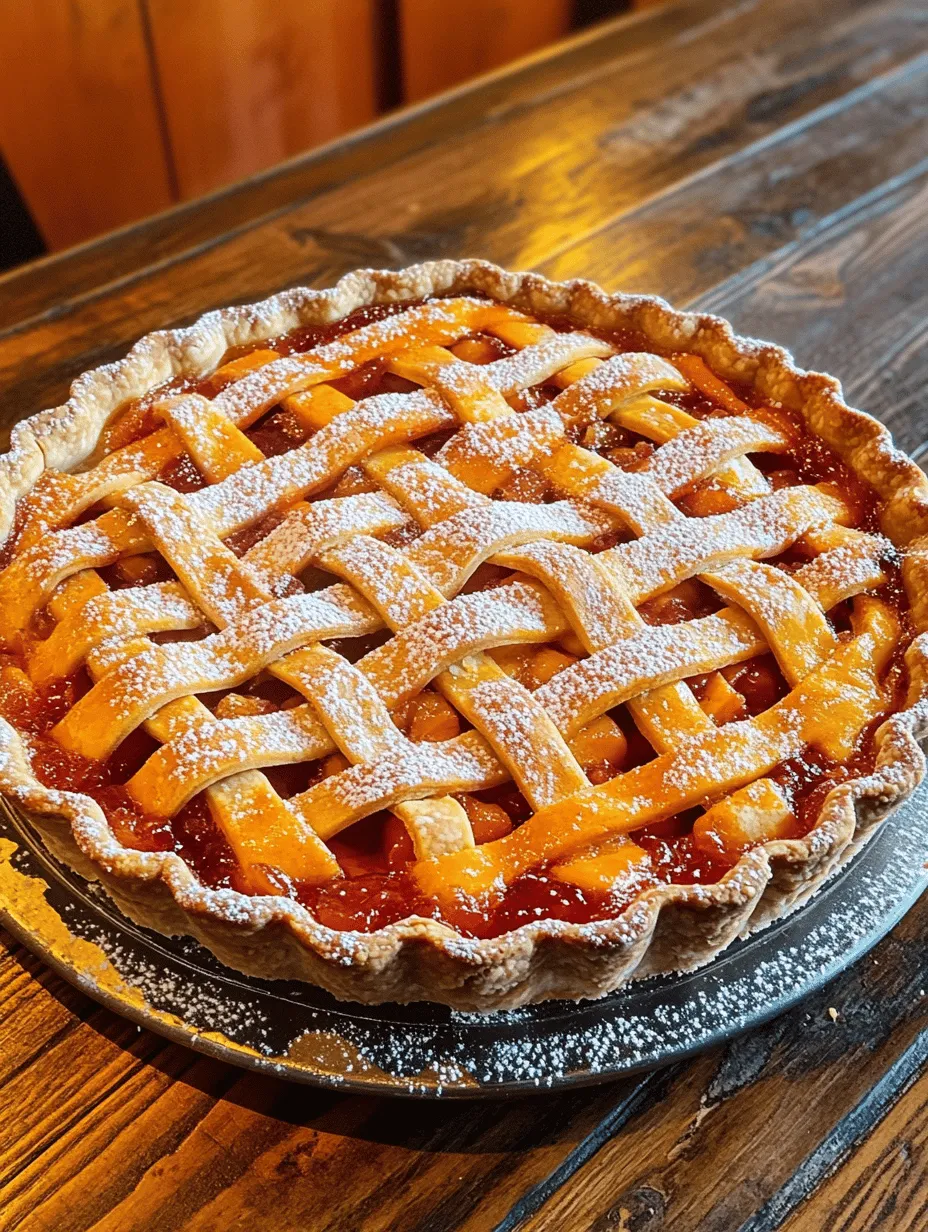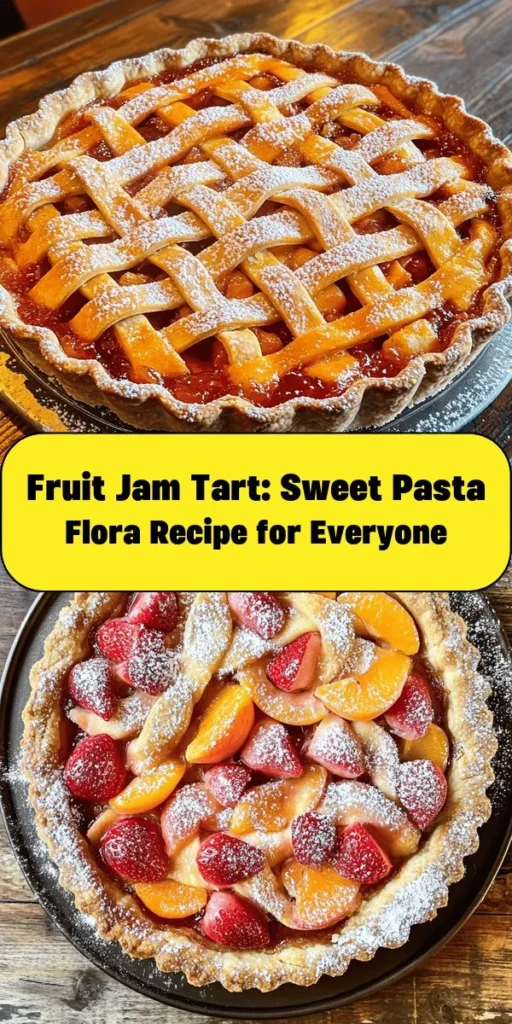Introduction
Pasta Flora, a traditional dessert with roots deeply embedded in Mediterranean cuisine, is a delightful treat that has captivated dessert lovers for generations. Originating from Greece and widely enjoyed throughout the Balkans, this scrumptious dessert is renowned for its buttery crust and luscious fruit filling. The name “Pasta Flora” itself translates to “Flour Pastry,” which perfectly encapsulates the essence of this delectable dish, combining the simple yet rich flavors of a classic pastry with the sweet brightness of fruit preserves.
The appeal of Pasta Flora lies not only in its exquisite taste but also in its versatility. This dessert can be adapted to various fruit jams, allowing for personal touches that cater to different palates. Whether you prefer the tangy sweetness of apricot or the classic allure of strawberry, Pasta Flora can easily accommodate your preferences, making it an excellent choice for any occasion. As you explore the steps and nuances of crafting this delightful treat, you’ll discover how simple ingredients can yield a dessert that is both visually appealing and satisfying to the taste buds.
Understanding the Ingredients
To create a perfect Pasta Flora Delight, it’s essential to understand the role each ingredient plays in the recipe. Here’s a closer look at the key components that come together to form this exquisite dessert:
All-Purpose Flour
All-purpose flour serves as the foundation of the Pasta Flora crust. It is crucial for achieving the right texture and structure. The gluten content in all-purpose flour allows the dough to hold its shape while remaining tender. When measuring flour, make sure to spoon it into the measuring cup and level it off with a knife to avoid using too much, which could lead to a dense crust.
Unsalted Butter
Using unsalted butter is recommended for this recipe as it gives you greater control over the flavor. Unsalted butter allows you to add the right amount of salt to the dough, ensuring that the sweetness of the dessert is balanced perfectly. Additionally, the butter’s fat content contributes to the rich, flaky texture of the crust, making it melt in your mouth with every bite.
Granulated Sugar
Granulated sugar plays a dual role in this recipe—sweetening the crust and enhancing its texture. The sugar not only adds sweetness but also contributes to the tenderness of the dough. When creamed with butter, sugar helps to incorporate air into the mixture, leading to a lighter and fluffier crust once baked.
Egg
The egg is a vital ingredient in Pasta Flora as it binds the dough together and provides leavening. The proteins in the egg help to create a stable structure, while also adding richness to the flavor. Be sure to use fresh eggs for the best results, as they contribute to the overall quality of the pastry.
Vanilla Extract
Vanilla extract is a flavor enhancer that elevates the overall taste of the dessert. A splash of vanilla brings warmth and depth that complements the sweetness of the fruit jam. Using pure vanilla extract rather than imitation can significantly improve the flavor profile of your Pasta Flora.
Baking Powder
Baking powder is an essential leavening agent that contributes to the lightness of the crust. It helps the dough rise slightly during baking, ensuring that the crust is not only flaky but also tender. Be mindful of the freshness of your baking powder, as expired leavening agents can hinder the recipe’s success.
Fruit Jam Options
The choice of fruit jam is one of the most exciting aspects of making Pasta Flora. While apricot and strawberry are classic options, you can experiment with other flavors such as raspberry or even mixed berry jams. Each jam brings its unique flavor, acidity, and sweetness, allowing you to customize the dessert to your liking. Opt for high-quality fruit preserves for the best taste.
Lemon Zest
Lemon zest is an optional but highly recommended addition that adds brightness and complexity to the overall flavor of the Pasta Flora. The citrus notes from the zest balance the sweetness of the jam and enhance the overall profile of the dessert. Use a microplane to finely zest the lemon, being careful to avoid the bitter white pith.
Powdered Sugar
Powdered sugar is typically used as a finishing touch for presentation. A light dusting of powdered sugar on top of the cooled Pasta Flora not only adds an elegant look but also a hint of sweetness that complements the fruit filling. It’s best to apply the powdered sugar right before serving to ensure it maintains its appearance.
Preparation Steps for Pasta Flora Delight
Now that we’ve explored the essential ingredients, let’s break down the preparation process for Pasta Flora Delight in a detailed, step-by-step guide. This will ensure that you create a delicious and visually appealing dessert with ease.
Step 1: Creaming Butter and Sugar
Begin by creaming together the unsalted butter and granulated sugar in a mixing bowl. Use an electric mixer at medium speed for about 3-5 minutes until the mixture is light and fluffy. This step is crucial as it incorporates air into the mixture, which contributes to a tender and airy crust. Make sure to scrape down the sides of the bowl periodically to ensure even mixing.
Step 2: Incorporating Eggs and Vanilla Extract
Next, add in the egg and vanilla extract to the creamed butter and sugar mixture. Beat the mixture until fully combined, ensuring that the egg is well incorporated. This step is essential for binding the dough and adding richness. The batter should appear smooth and creamy.
Step 3: Integrating Dry Ingredients
In a separate bowl, whisk together the all-purpose flour and baking powder. Gradually add the dry ingredients to the wet mixture, mixing on low speed until just combined. Be careful not to overmix, as this can lead to a tough crust. The dough should come together nicely, forming a soft but slightly sticky consistency.
Step 4: Chilling the Dough
Once the dough is formed, wrap it in plastic wrap and refrigerate for at least 30 minutes. Chilling the dough is a critical step that helps to firm it up, making it easier to roll out later. It also allows the flavors to meld together, enhancing the overall taste of the crust.
Step 5: Preheating the Oven
While the dough chills, preheat your oven to 350°F (175°C). Preheating the oven is essential for ensuring that your Pasta Flora bakes evenly and develops a beautiful golden color. A properly heated oven also helps the crust rise and maintain its flaky texture.
Step 6: Rolling Out the Dough
After the dough has chilled, remove it from the refrigerator and place it on a lightly floured surface. Using a rolling pin, roll out the dough to about a ¼-inch thickness. Be mindful of the shape and size needed for your tart pan. If the dough is too sticky, you can dust it with a little more flour as you roll.
Step 7: Fitting the Dough in the Tart Pan
Carefully transfer the rolled-out dough to a tart pan. Gently press the dough into the bottom and up the sides of the pan, ensuring there are no gaps or tears. If there are any cracks, patch them with leftover dough. Trim any excess dough that hangs over the edges for a clean finish.
Step 8: Spreading the Fruit Jam
With the dough in the tart pan, it’s time to spread the fruit jam of your choice over the crust. Use a spatula to evenly distribute the jam, ensuring that it covers the entire base. Be generous but not overly thick, as too much jam can make the crust soggy. If you’re using lemon zest, sprinkle it over the jam for an extra burst of flavor.
As you embark on the journey of making Pasta Flora Delight, remember that the process is as enjoyable as the result. This traditional Mediterranean dessert brings together simple ingredients to create a rich and satisfying treat that is sure to impress your family and friends. Stay tuned for more detailed steps on baking and finishing your Pasta Flora in the following sections.

Crafting the Lattice Topping: Techniques for Creating an Appealing Presentation
Creating a lattice topping for your Pasta Flora Delight not only enhances its visual appeal but also provides a delightful texture contrast to the smooth fruit filling beneath. The lattice design is traditional and can be perfected with a few simple techniques.
Step-By-Step Lattice Technique
1. Roll Out the Dough: After chilling your dough, roll it out on a lightly floured surface, aiming for an even thickness of about 1/8 inch. If the dough is too soft, refrigerate it for another 15 minutes to make it easier to handle.
2. Cut Strips: Using a sharp knife or a pizza cutter, cut the rolled-out dough into strips, approximately 1/2 inch wide. Ensure the strips are uniform for a clean look.
3. Weaving the Lattice: Begin by laying half of the strips parallel to each other over the fruit filling in your tart. Space them evenly apart. Next, take one of the remaining strips, place it over one of the horizontal strips, and weave it under the next one. Continue this pattern, alternating the strips until the lattice is complete.
4. Seal the Edges: Trim any excess dough from the edges and pinch the lattice strips to the crust’s edge to create a decorative finish.
5. Egg Wash: For a golden, glossy finish, brush the lattice with a mixture of beaten egg and a splash of milk before baking.
Baking Specifics: Monitoring the Color and Texture for Doneness
Baking and Cooling Process
Baking your Pasta Flora Delight requires careful attention to temperature and time to achieve that perfect golden crust and a bubbling fruit filling.
1. Baking Time and Temperature: Preheat your oven to 350°F (175°C). Place your assembled tart in the center of the oven and bake for 35-40 minutes. Keep an eye on the color; the crust should turn a lovely golden brown.
2. Signs of Doneness: To ensure your Pasta Flora is perfectly baked, look for a solid crust with a slight jiggle in the filling. The fruit should bubble gently, and the lattice should be crisp and golden.
3. Cooling Times: Patience is key when it comes to cooling your dessert. Allow it to cool in the pan for at least 10-15 minutes before transferring it to a wire rack. This cooling period helps the filling set and the flavors meld beautifully. As it cools, you’ll notice the texture will change; it will become firmer and easier to slice.
Serving Suggestions and Pairings
Presentation is essential when serving your Pasta Flora Delight. Here are some tips and suggestions to elevate your serving experience:
Presentation Tips
– Garnishing: Dust the top of your cooled tart with powdered sugar and a sprinkle of fresh lemon zest just before serving. This not only adds a touch of elegance but also complements the sweetness of the fruit filling.
– Slice with Care: Use a sharp knife to cut even slices, ensuring each piece captures both the crust and the filling.
Pairing Ideas
Pasta Flora Delight pairs wonderfully with a variety of beverages:
– Coffee and Tea: Serve with a robust espresso or a fragrant herbal tea to balance the sweetness of the dessert.
– Ice Cream: A scoop of vanilla or lemon sorbet on the side adds a refreshing contrast to the tart.
Versatility for Various Occasions
This delightful dessert is perfect for any occasion, whether it be:
– Family Gatherings: Serve it as a comforting dessert after Sunday dinner.
– Parties: Slice it into smaller pieces for an easy-to-eat treat at gatherings.
– Casual Treats: Enjoy it with your afternoon coffee or as a delightful snack.
Cultural Significance and Variations of Pasta Flora
Pasta Flora, with its rich history, is a beloved dessert in Mediterranean culture, particularly in Greece and Italy. Understanding its origins and variations can enhance your appreciation of this delightful treat.
Historical Background
Pasta Flora is believed to have its roots in the traditional Greek and Italian kitchens, where it was often made with seasonal fruits and served during festive occasions. The dessert is a testament to the Mediterranean way of life, promoting the use of fresh, local ingredients.
Variations Across Countries
– Greece: In Greece, it is commonly made with quince or apricot jam, reflecting the local fruit availability.
– Italy: Italian versions might incorporate nuts into the crust or use different fruit preserves, showcasing regional preferences.
Alternative Fillings
While traditional recipes often call for specific fruit jams, the beauty of Pasta Flora lies in its adaptability. Here are some alternative fillings you might consider:
– Berry Jams: Raspberry or blueberry preserves add a tangy twist.
– Stone Fruits: Peach or cherry preserves can bring a delightful sweetness.
Creative Twists
For those looking to add a unique touch to their Pasta Flora Delight, consider:
– Spices: Incorporating cinnamon or nutmeg into the dough can enhance the flavor profile.
– Nuts: Adding finely chopped nuts, like almonds or walnuts, into the crust can give a lovely crunch and depth.
Nutritional Information
Understanding the nutritional side of Pasta Flora Delight can help you enjoy this dessert mindfully.
Nutritional Overview
Per serving (1 slice, assuming 12 servings):
– Calories: Approximately 210-250
– Fats: 10-12g
– Carbohydrates: 30-35g
– Sugars: 10-15g
Healthier Substitutions
If you want to make the recipe a bit healthier, consider these substitutions:
– Whole Wheat Flour: Use whole wheat flour instead of all-purpose for added fiber.
– Reduced Sugar: Opt for less sugar in the filling or use natural sweeteners like honey or maple syrup.
– Fruit Variations: Use unsweetened fruit preserves or fresh fruit to reduce sugar content.
Conclusion
Pasta Flora Delight is more than just a dessert; it’s a celebration of flavors and memories, offering a delicious way to connect with tradition. The joy of crafting this beautiful tart, from the buttery crust to the luscious fruit filling, is matched only by the pleasure of sharing it with loved ones. With its versatility, it can grace your table during any occasion, from family gatherings to casual afternoons.
Creating this beloved treat from scratch not only delights the palate but also evokes warmth and nostalgia, making Pasta Flora a cherished part of culinary heritage. So gather your ingredients, embrace the process, and enjoy the sweet satisfaction of serving up a slice of homemade Pasta Flora Delight.



